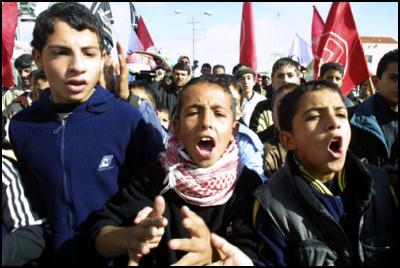Sonia Nettnin: Film Review - A Stone's Throw Away
Film Review: A STONE’S THROW AWAY
By Sonia Nettnin

The Palestinian boys
talked about their friend, Kiftah, who was killed by an
Israeli soldier (above). Before his death, they had dreams
of becoming football players and journalists. Curfews
prevent them from attending school. Through film, their
life Accounts are a stone’s throw away (photo courtesy of
Chicago Palestine Film Festival).
“I lost the will to live when I lost my friend,” the boy said. “But Kiftah will always be in my heart…I will never forget him.”
A STONE’S THROW AWAY is a documentary about life under military occupation and the Palestinian youth who suffer from it.
Line Halvorsen directed the film (2002), which won best documentary at the Norwegian Film Festival (2003). This weekend is the film’s final showing at the third annual Chicago Palestine Film Festival.
Halvorsen interviewed youth from the Dheisheh Refugee Camp, located outside of Bethlehem. The boys expressed their feelings about Kiftah – 13-years-old – killed eight months prior to their reflections.
The boys described the tragedy and Halvorsen provided film footage.
The soldier shot Kiftah from the cemetery, in-between the graves.
First, Kiftah fell on his back. Then, his head hit the ground. They carried him by a tree. Kiftah screamed and his eyes overturned into his head. Blood soaked his t-shirt.
Men carried him into an ambulance and the boys watched the door shut.
In the hospital room, the film is in slow motion. His mother screamed and she clasped her head with her hands.
The boys talked about how they played football together. When he was alive, Kiftah told jokes that brought laughter. Not anymore. Within seconds, they named off twelve boys killed in the last, several months.
In a funeral procession, they draped Palestine’s flag over the body. People kissed their cheeks. Crowds shouted in the streets.
When soldiers killed their friend, the boys explained their humiliation. Halvorsen filmed the boys on the ground, who ran from tanks in the streets.
Stone-throwing is resistance to the occupation. Moreover, it is retaliation to the humiliation. A stone is hard, but small, compared to a tank. Halvorsen filmed their interaction.
When thrown, a stone rises and it falls in the air. Its projectile is not the same as bullet fire. However, a tank’s trajectory has life consequences for the boys. Tanks and planes are force. For every action there is a reaction – and this dynamic has a life of its own.
“I have stopped caring about anything,” another boy said.
The youth cannot attend school because of 24-hour curfews. They wondered if they would progress to the next grade. Sounds of gun shots and grenade drops made studies difficult; and it cancelled exams (again).
Halvorsen filmed the boys on rooftops, which is one of the few places for human interaction. The boys watched for Israeli forces. Soldiers roamed the streets with Uzis. When they heard gunshots, the boys hid in rooms.
“No, it’s not entertainment,” one boy said. “We feel strangled.”
In the background, a violin played a melancholy solo.
Scarce jobs and lack of businesses created frustration for the boys as well. Warfare sounds permeated the film. One boy talked about sleeping difficulties.
Months after Kiftah’s death, the boys walked to the cemetery. They carried bright green bushes and bottles of water to his grave.
His life account is a stone’s throw away
Sonia Nettnin is a freelance writer. Her articles and reviews demonstrate civic journalism, with a focus on international social, economic, humanitarian, gender, and political issues. Media coverage of conflicts from these perspectives develops awareness in public opinion.
Nettnin received her bachelor's degree in English literature and writing. She did master's work in journalism. Moreover, Nettnin approaches her writing from a working woman's perspective, since working began for her at an early age.
She is a poet, a violinist and she studied
professional dance. As a writer, the arts are an integral
part of her sensibility. Her work has been published in the
Palestine Chronicle, Scoop Media and the Washington Report
on Middle East Affairs. She lives in Chicago.


 Howard Davis: NZSQ Inaugurates Wellington Chamber Music’s New Season
Howard Davis: NZSQ Inaugurates Wellington Chamber Music’s New Season Gordon Campbell: On The Trump Upside, And Peters Persecution Of Trans People
Gordon Campbell: On The Trump Upside, And Peters Persecution Of Trans People Binoy Kampmark: Yale, Ben-Gvir and Banning Palestinian Groups
Binoy Kampmark: Yale, Ben-Gvir and Banning Palestinian Groups Ramzy Baroud: The Myth Of Conquest - Why Gaza Will Never Be Subdued By Israel
Ramzy Baroud: The Myth Of Conquest - Why Gaza Will Never Be Subdued By Israel Binoy Kampmark: Fallibility, Dirty Wars And Pope Francis I
Binoy Kampmark: Fallibility, Dirty Wars And Pope Francis I Peter Dunne: Dunne's Weekly - An Issue No-one Can Afford To Lose
Peter Dunne: Dunne's Weekly - An Issue No-one Can Afford To Lose